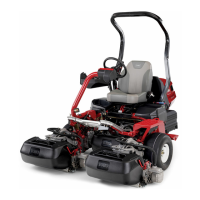T owing the Machine
Note: Refer to Figure 30 for this procedure.
g389185
Figure 30
1. Nut 4. Arm-bracket hole
2. Spring 5. Actuator shaft
3. Spring length—1 1.4 cm
(4.5 inches)
T o tow the machine, you must perform the following
procedure to release the brake actuator:
1. Engage the parking brake.
2. Remove the key and disconnect the main-power
connectors.
Important: If the main-power connectors are
connected while towing, electrical damage
may result.
3. If the 3-Wheel Drive Kit is installed, disconnect
the kit-wire-harness connectors from the main
wire harness.
Important: If the kit and machine wire
harnesses are connected while towing,
electrical damage may result.
4. Chock both sides of the front tires.
5. Release tension on the spring by loosening
the nut that secures the eyebolt to the spring
bracket ( Figure 30 ).
6. Remove the spring.
7. Insert a ratchet (3/8 inch) through the hole of the
arm bracket and push in the actuator shaft.
DANGER
When the actuator is released from the
brake, the machine is able to free wheel.
A free-wheeling machine can cause
serious injury to bystanders.
If the machine is not being towed, engage
the parking brake.
8. Have an assistant sit in the seat, fasten the
seatbelt, and use the brake while you tow the
machine.
Note: This ensures that the machine is under
control when you tow the machine.
9. Remove the chocks from the tires.
10. When the machine is ready to be towed,
disengage the parking brake.
1 1. Use the rear castor fork to tow the machine
( Figure 31 ).
Important: Do not exceed 5 km/h (3 mph)
while towing the machine. Damage to the
electrical components may result.
g389187
Figure 31
1. Rear castor fork
After you have towed the machine to your intended
destination, perform the following steps:
1. Engage the parking brake.
2. Remove the tow strap from the castor fork.
3. Install the spring as shown in Figure 30 .
36

